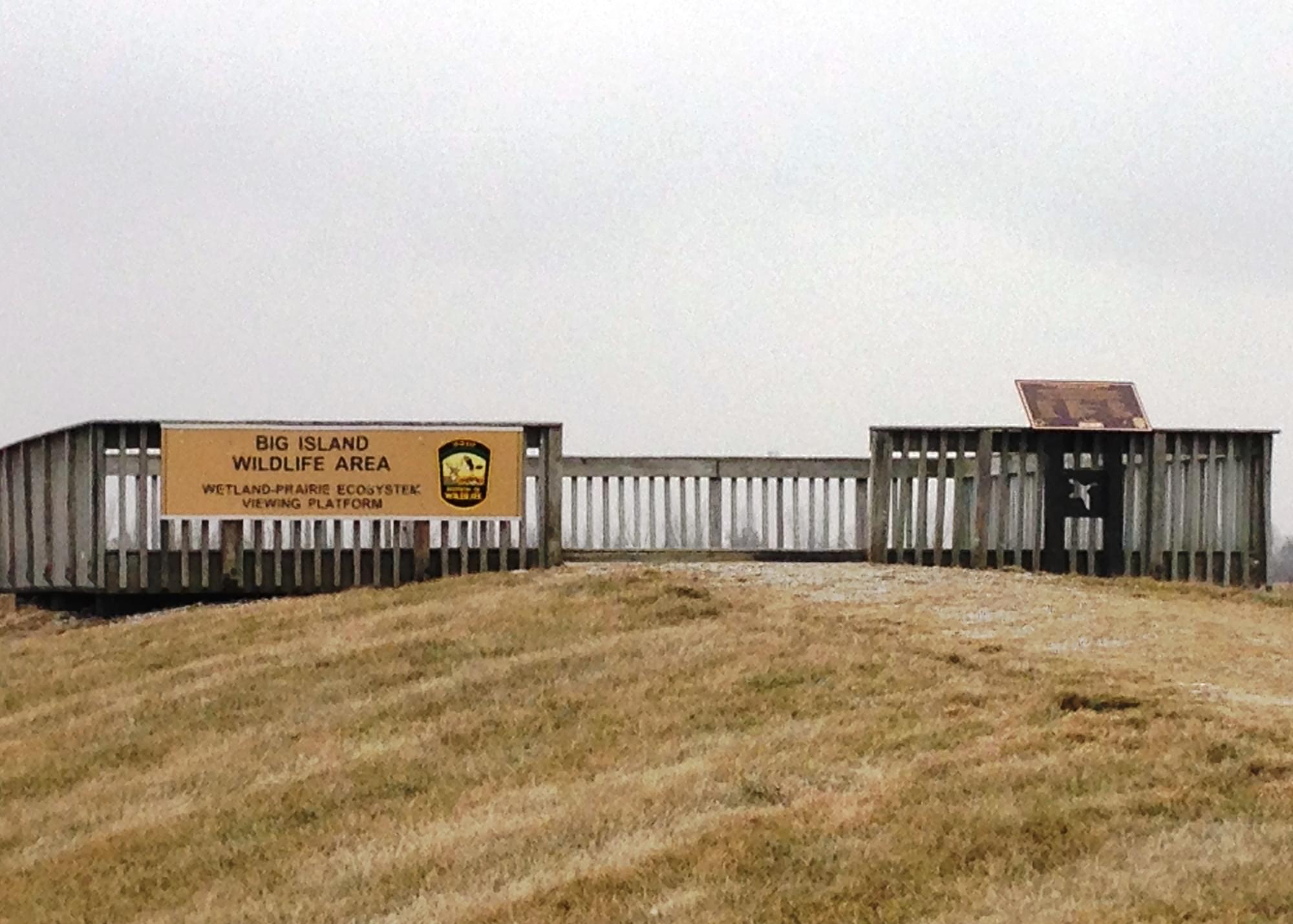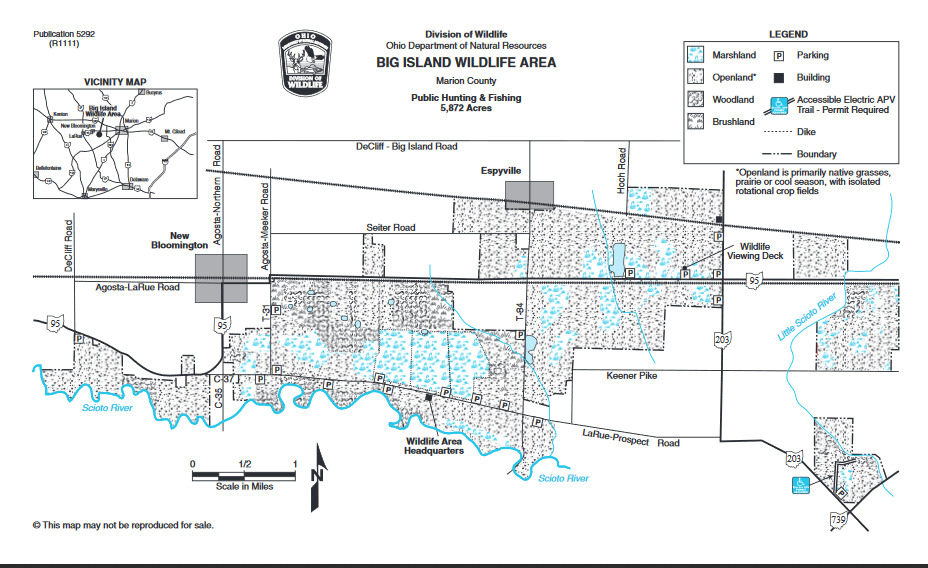Big Island Wildlife Area

Big Island Wildlife Area
New Bloomington, OH 43341
Big Island Wildlife Area Official WebsiteBig Island Wildlife Area map
Also, see all the hotspots at:
Killdeer Plains-Big Island Important Bird Area
Tips for Birding
Big Island is approximately 5000 acres in size, and is situated within a major flyway for waterfowl and shorebirds traveling from the Ohio River to the Western Basin of Lake Erie.
Approximately 265 species have been recorded here for one of the highest wildlife area checklist tallies away from Lake Erie. It is separated into about 10 units. Seven of these units are dominated by wetlands and are the largest concentration of wetlands in the interior of the state. Three contiguous wetland units of traditional diked construction are located along the La Rue–Prospect Road approximately 4 miles southeast of the village of LaRue and parallel to the Scioto River. The middle of these diked wetlands was has been off-limits during the spring and summer since 2003 due to the presence of a Bald Eagle nest in woodlands to the north. The remaining wetlands, restored in 1999-2000, are open levees with water backing up against earthen dams providing for a variety of water depths, and consequently a variety of water birds.
The principal units of the new restoration are accessible off OH-95 south and east of Espyville (OH-95 leads directly west out of Marion). Two up-ground and one in-ground reservoir of small size offer occasional use by deep-water waterfowl such as bay ducks. Terns will visit briefly as has the rare Laughing Gull in recent years.
Trails are non-existent. There is one viewing deck off OH-95 and the dikes around the up-ground reservoirs provide some elevation for scoping across these very large units. However, to get the most out of the site, one is encouraged to trek across some of the landscape. This can be particularly rewarding in and around the up-ground reservoir of Unit D (north side of OH-95 exactly 1 mile west of OH-203). Here in November 1998, a Northern Wheatear was observed for 10 days. Both Le Conte’s and Nelson’s Sharp-tailed Sparrow have been discovered within the agricultural ditch immediately west of the reservoir, while only the 2nd state nesting of Wilson’s Phalarope took place there in 2001.
A Bell’s Vireo took up a territory on the railroad tracks across OH-95 from this location. Apart from the OH-95 wetlands, do not overlook the wetlands immediately south of the LaRue-Prospect Road, and also those accessed west of the little town of Espyville (north side of tracks) at the end of Hoch Road. A relatively unknown birding area is the abandoned railroad tracks along the north side of the wildlife area.
This abandoned railway is open as the Marion Tallgrass Trail. This area can be accessed either from OH-203 (parking pull-off) or from Espyville, at the western end. This two-mile stretch of brushy habitat with a low canopy trees may prove an interesting walk for songbirds at times of potential spring fallouts.
Open dawn to dusk. With the advent of dove and teal season around September 1st, hunting pressure can be heavy at times and can greatly diminish the birding experience through January. This is especially true of the new restoration areas.
A number of gravel pull-offs and parking areas provide suitable access to most of the units.
For two to four miles in any direction, especially to the southwest and northeast, the surrounding land often floods in the spring, offering skypool habitat for shorebirds and waterfowl. It is often rewarding to drive the roads in this surrounding countryside. Be sure to check the pools along OH-95, toward Marion.
Birds of Interest
Winter
This wildlife area can be interesting early in the season with the presence of Bald Eagle, Short-eared Owls, Northern Harriers, and Rough-legged Hawks putting on quite a raptor show. This is a good time and area for shrikes. Although the Northern Shrike has been identified here three times in recent years, the Loggerhead Shrike is a good candidate at any time of the year as this species has been recorded just eight miles to the north at Killdeer Plains Wildlife Area for the past three winters and another was detected in 1996 just four miles north of Espyville. Chickadees are rare here in winter.
The Carolina Chickadee, which nests in many of the woodlots, retreats along the Scioto River corridor. During invasion years, the Black-capped Chickadee has been discovered along the northern perimeter of the wildlife area in Espyville. So long as the water is free of ice, waterfowl can be numerous, with puddle ducks in the thousands through late December.
Spring
March is a parade of waterfowl from swans to Canvasbacks, as well as the puddle ducks. Two dozen species are possible here in late March. At this time, the first shorebird arrivals are recorded in the form of yellowlegs and Pectoral Sandpipers. These species may become quite numerous with state records for the interior recorded here. Up to 3300 Pectoral Sandpipers in April of 1998, and well over 400 Lesser Yellowlegs in more recent years have been tallied at Big Island wetlands. The American Golden Plover can also be common in some years. Peeps are less conspicuous but this may be the best inland site for White-rumped Sandpiper (late May and early June).
A specialty for Big Island is the Upland Sandpiper which holds on here with 5 nesting pairs. Look for it from 10 April onwards along OH-95 and Espyville Road. If habitat should persist into May, the Short-billed Dowitcher has also been recorded here in good numbers. Herons flock to the site, including transient Great Egret and Cattle Egret. American Coot, numbering 3000 or more, is practically an annual tradition here in April. Wilson’s Snipe may be very numerous in the shallow mud areas as are the migrating American Pipit; frequently in the 100’s. Along with Killdeer Plains W.A., the units along Rt. 95 are a magnet for staging Lapland Longspurs which frequently exceed 1000 for an early April peak; some years full breeding plumage is obtained and dozens of birds may begin their territorial skylarking here.
Summer
This is one of the more exciting places to bird in summer, away from Lake Erie. There is the potential for vagrants, the late departure of migrants, and the early arrival of fall shorebirds. But it is the summer breeders which can fully occupy one’s time. Rare nestings in recent years have included Green-winged Teal, several Northern Shoveler broods, Ruddy Duck, and the aforementioned Wilson’s Phalarope. Bell’s Vireo has appeared here in June. The Least Bittern, normally very rare and difficult to locate away from Lake Erie, is a regular nesting species here with about five pairs in the LaRue wetlands. Be sure to check the roadside ditches holding a few cattails in late July when the young bitterns first become independent and wander from their natal territory. This can make for some amusing and close encounters. Marsh Wrens also breed here in the LaRue wetlands, as do about a dozen pairs of the Common Moorhen and 6-10 pairs of Pied-billed Grebe; the largest concentration of these species away from Lake Erie in Ohio.
A Yellow-headed Blackbird once appeared on territory and Northern Harrier has occasionally nested here. Among songbirds, the real attraction has been the grassland birds; especially the Grasshopper Sparrow (50+ territories), Vesper Sparrow (12+ territories), Bobolinks (20+ pairs), and Dickcissel (20-90 territories). Orchard Orioles and Brown Thrashers have territories all along the abandoned railroad tracks.
Fall
Of the four seasons, this area is probably birded less in the Fall, likely owing to the hunting traffic. This can, however, be a very exciting season for birding here. A Northern Wheatear appeared in November of 1998 for only the 2nd Ohio record. The southward flight of swallows, especially that of the Tree Swallow, can be spectacular with staging concentrations in September exceeding 5000 birds.
Big Island is directly in the path of the southward migration of the Double-crested Cormorant with peak morning passages in the past, between 8:45 and 9:30 AM after a cold front has passed, exceeding 5000 birds for several years. These sightings may exceed 1000 as early as mid-August with numbers increasing to 8600 by October. Optimal viewing of this phenomenon is from the hill adjacent to the up-ground reservoir on OH-95. By late November, watch for the passage of Lapland Longspurs and Snow Buntings.
About Big Island Wildlife Area
See all hotspots at Big Island Wildlife Area
This 5,872-acre wildlife area is located five miles west of Marion on OH-95. The terrain is very flat. Sixty percent of the area is open land consisting of crop fields, meadow, and prairie grasses in large open fields. Second- and third-growth hardwoods occupy another 20 percent of the area. Pin oak, hickories, and silver maple are common species in the upland woods. Sycamore, box elder, ashes, and silver maple occur along the Scioto River. Index of Ohio’s trees from the Division of Forestry. Ponds, potholes, and over 1,200 acres of marsh and wetland occupy approximately 20 percent of the area.
The Big Island Wildlife Area lies within a former wetland prairie, one of the larger prairies that existed in Ohio at the time of settlement. Agricultural development of the area did not begin until the late 1800s, because of the poor drainage. Farming on these poorly drained soils was a marginal enterprise, with bumper crops harvested during years of favorable weather and practically no crops produced during poor years. Most of the once expansive tallgrass prairie on the area was lost because of the intensive agricultural use and drainage work that occurred prior to purchase by the Division of Wildlife.
Purchase of the land for this wildlife area began in 1958. Management work in the past has included the protection and improvement of existing woodland, nest box installation, planting of trees and shrubs and prairie and other grasses for nesting cover, contract grain farming for increased food supply, and wetland construction.
A 382-acre marsh, constructed in 1971, is flooded in the fall by water pumped from the Scioto River. This seasonally flooded marsh provides nesting, feeding, and resting grounds for wetland-dependent birds and furbearers and is especially attractive to spring and fall migrating shorebirds and waterfowl. The abundance of wetland wildlife attracted to the marsh along with the overall diversity of the area makes Big Island a popular area for hunters and wildlife watchers. This area is a Watchable Wildlife Area.
Habitat management activities on this wildlife area are ongoing and are constantly improving the area, especially for wetland and grassland-dependent wildlife species. Since 1996 nearly 3,800 additional acres were purchased to enlarge the wildlife area. These 3,800 acres have been converted to a combination of prairie grassland habitat and shallow wetlands, which has made Big Island the site of the largest wetland prairie area on public land in Ohio.
No restroom facilities in the wildlife area. There are portable toilets at some of the Marion Tallgrass Trail trailheads.
Features
Roadside viewing
Restrooms on site
Content from Big Island Wildlife Area Official Website and Ohio Ornithological Society
